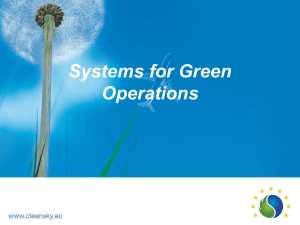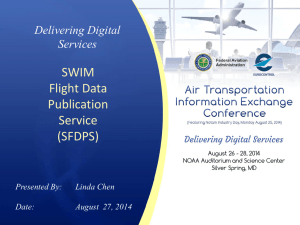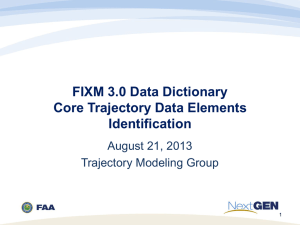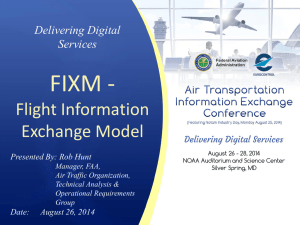What is SESAR?
advertisement
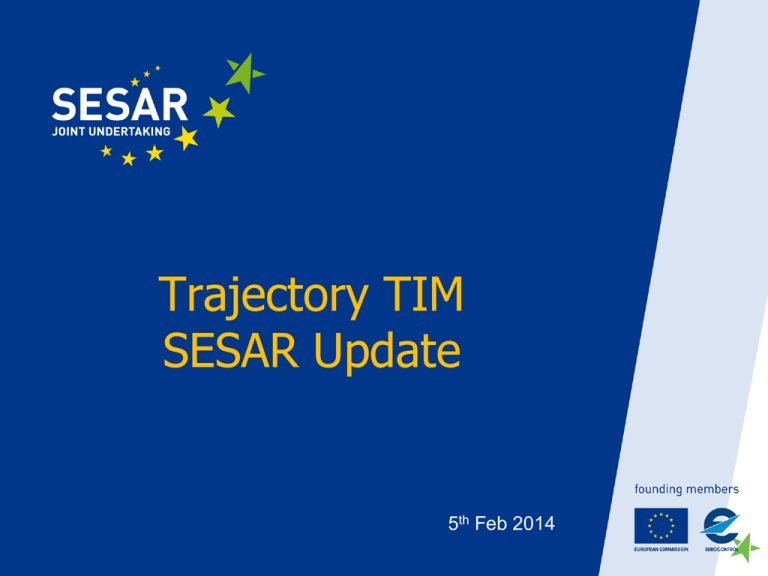
Trajectory TIM SESAR Update 5th Feb 2014 What is SESAR? • Single European Skies ATM Research • European air traffic control infrastructure modernisation programme. • Aim is to develop new generation ATM system • Give Europe a high-performance ATC infrastructure to enable: Safety, Capacity, Efficiency – Cost & Environmental SESAR MembersSJU Members SESAR Phases Definition phase Resulted in the European ATM Master Plan & Target Concept Development phase – ( R & D phase) Managed by the SESAR Joint Undertaking (SJU) 1. Deliver Early Wins 2. Develop Mature Concepts 3. Research, validate and develop technological solution for future concepts Deployment phase Implements the results Deploys harmonised systems. Delivers the performance increase foreseen in the ATM Master Plan 2014-2020 2006-2008 June 2009-2016 Page 4 SESAR Work Packages WPB: Target Concept Maintenance WPC: ATM Master Plan WP3: Validation Infrastructure WP4 En Route Operations WP5 TMA Operations WP6 Airport Operations WP7 Network Operations Operational Work Packages WP8: Information Management WP12 Airport Systems WP11 AOC WP10 ATC Systems WP9: Aircraft Systems WP14: SWIM WP15: CNS WP16: Transverse Areas Key Operational System Tranversals WP13 NIMS SESAR Trajectory Concept 5th Feb 2014 Trajectory Based Operations • Trajectory Based Operations are at the core of the SESAR Concept: • Enhanced predictive capabilities and reactivity of the network. • Information sharing and collaborative processes providing more flexibility for the airspace users when changes are required. • The Trajectory Management concept: • Entails the systematic sharing of aircraft trajectory data between participants in the ATM process. • Ensures that all participants have a common view of a flight and access to the most accurate data available to perform their tasks. • The Trajectory is the principal language for information exchange supporting CDM, planning and analysis and automation. SESAR Business Trajectory • Operators define and share their preferred profile for the intended flight – the Shared Business Trajectory (SBT) • Through negotiation with Network Management and ANSPs the Reference Business Trajectory (RBT) is agreed. • The flight is executed as closely as possible to the operator’s intention – with RBT changes agreed with the operator. Sharing of the Trajectory: Arrival Management Tools 4D – Trajectory Management AOC Airport Trajectory Sharing Enhanced Separation Tools – e.g. MTCD Network Optimisation CFMU ANSP A ANSP B Slide 9 Trajectory Accuracy Needs vs Planning Horizon Increasing FIDELITY Safety Nets of Trajectory Conflict Detection & Resolution Tools Separation Provision Planner Support Tools Conformance Monitoring Multi Sector Planning E.g. iFACTS, CATO, ERATO / ERASMUS Sequencing & Complexity Management Arrival Management Tools Departure Management Complexity Tools Tools Network & Capacity Management FDP systems E.g. AMAN Network Planning Tools E.g iTEC / CoFlight, CFMU Increasing LOOK AHEAD Minutes Hours Days time Page 10 Operational Scenarios & Trajectory Management Framework Developing Trajectory & Information Models • Review of SESAR Concept of Operations Focus on current & near term operational scenarios In ICAO terms – these scenarios relevant to FF-ICE/1 – FIXM v3.0 & v4.0 In SESAR terms approximately Step 1 secnarios – but not an exact match • Identify Operational Scenarios Grouped by SESAR Concept area: Pre-Flight Phase (WP 7) Airport Operations (WP 6) TMA – Arrival & Departure (WP 5) En-Route & Oceanic (WP4) • Analyse Information & Trajectory Exchange needs Input into SESAR Data Model (AIRM) and Service Model (ISRM) (WP8) Input to global data modelling work – FIXM !! Page 12 SESAR Scenarios for Pre-flight phase • Initial provision of schedule information SESAR use cases have been developed to formalise information flows between airspace users and the Network Manager for the provision of schedule information (Shared Business Trajectory information) • Provision of a 4DT by an AU SESAR use cases have been developed for the Extended Flight Plan (EFPL) allowing the AU to provide in the flight plan full 4D trajectory information as well as flight specific performance data. • Pre-flight trajectory update and revision Trajectory update and revisions by the airspace user - As above with specific use case for flights given TTO or TTA targets Trajectory revisions by ATM - European STAM process – short term ATFCM measures Trajectory Revisions triggered by airspace/route changes - Activation & De-activation of Temporary Segregated Airspace (TSA) Page 13 SESAR Scenarios for Pre-flight phase (2) • Trajectory Checking (Syntax / Logic / Consistency) With the introduction of Extended Flight Plan the verification of the flight plan will be adapted to take into account the 4D trajectory element. Both syntax and consistency check will be adapted. • Trajectory Options Provision and Selection Currently in Europe, only one FPL (so only one trajectory option) is allowed per flight. The improvement of CDM processes related to STAM measures will allow airspace users to express preferences. No mature SESAR use-cases are available related to multiple-trajectory options or user preferences. Page 14 Scenarios for Departure • Departure Sequencing Management of the departure sequence to reflect airport & network constraints Current European operating method uses Target Take-Off Time (TTOT) Future SESAR concept will move to Target Time of Arrival (TTA) Need to share and coordinate times through the SBT/RBT • Departure clearance provision Issuing of the Departure Clearance Update of the departure time (TSAT) when necessary Use of datalink to deliver clearance information • Departure clearance verification and revision • Potential for Target Times (e.g. TTOT) to be updated according to traffic & other operational circumstance Page 15 Scenarios for Departure (2) • Collaborative Queue Management Where appropriate, the optimisation of the departure sequence (see above) will take into account wider traffic load balancing – i.e. factors related to the arrival sequence • Taxi Clearance Provision Request and issue of Taxi clearance In future this will be done by datalink • Take-Off Clearance Take-off clearance, following departure clearance route & constraints Page 16 Scenarios for En-route & Oceanic • Coordination Notification – achieved through SWIM-based trajectory sharing in future (Interoperability – IOP) Initial Proposal E.g. standard coordination based on Letter of Agreement Negotiation and Acceptance • Metering & Extended Metering Coordination with AMAN procedures (TMA Arrival) Sharing of AMAN information – could be: Target times on a specific fix (TTA, CTA) Time To Loose/ Time To Gain Speed advisories And/or sequence order information Page 17 Scenarios for En-route & Oceanic (2) • Trajectory Prediction Improvement of Ground-Based Trajectory Predictors through use of shared trajectory information Information from FOC (e.g. EFPL information) Information from aircraft (e.g. downlinked Extended Projected Profile) • Oceanic Operations Provision of oceanic clearances Improved transition from oceanic airspace into European continental airspace E.g. sharing of airborne and FOC data to improve or update shared trajectory • Complexity Management Use of shared trajectory information to improve traffic load predictions Supports local traffic complexity management tools • Separation Management Use of shared trajectory information to as input to controller tools: Conflict detection tools (MTCD) Conformance Monitoring Page 18 Scenarios for Arrival • Metering into terminal airspace AMAN support tools are used to provide optimal arrival sequence using Extended AMAN horizon AMAN calculates a Target Time (or Controlled Time of Arrival) for each flight CTA constraints are coordinated with flight and between ATSUs (Trajectory Management) • Provision of descent clearance Greater use of RNP- based arrival routes Where possible facilitating Continuous Descent Approaches Needs support for RNP procedures in information & trajectory exchanges • Conformance Monitoring to Cleared Procedures Use of conformance monitoring to support tactical & planner controllers Agreed (cleared) trajectory information input to tools Page 19 Scenarios for Arrival (2) • Ground-based assisted merging and spacing Supervision of the implemented arrival sequence using approach controller guidance to maintain separation and spacing System support to controller to provide instructions (e.g. speed instructions) • Flight-deck interval management Approach Controller give instructions to Flight Crew for ASAS S&M manoeuvre in view of sequencing and merging towards the approach • Approach clearance Clearance of traffic onto intermediate and final approach using advanced RNP routes Page 20 SESAR Trajectory Management Framework (TMF) • The SESAR TMF coordinates the use of trajectory information across operational concept elements: It provides a consistent method of managing the RBT - ensuring a consistent view of the flight is shared and maintained. • • TMF is a facilitator for the operational concepts of SESAR, not an operational concept in itself The TMF: Describes scenarios and use cases involving the exchange of trajectory information Who are the actors? What is the information exchanged? Who does what with the information: - Who produces the information ? - What should the consumer do with the information? Page 21 SBT/ RBT Content Flight Script Flight Intent / Trajectory Constraints SBT / RBT Data Shared via Flight Object 4D Predicted Trajectory Agreed 2-D route Agreed Planned Level and Speed Vertical / Speed / Time Constraints Initial State (reported position & time , mass ..) Links to Applied ATM Constraints Other Supporting Data e.g. user preferences, .... 1. 4D Predicted Trajectory: The sequence of trajectory points – latitude, longitude, altitude and time for each. 2. Flight Script: includes constraints (altitude / time / speed) and agreed route intent which are inputs to buidling the trajectory – whether by the FMS or Ground TP. Example Use Case: Standard Coordination of a Flight (1) Operational Activity Description: ATS Unit (Downstream) ATS Unit (Upstream) Step Operating Method 1 Flight reaches coordination trigger point (time/distance from boundary) OR Forced by the controller using the HMI When the flight reaches a predetermined time/distance (as set by LOA) from the common ATS unit boundary, the upstream ATS unit automatically updates the Flight Object with a coordination offer for the downstream ATS unit (if the flight is not already coordinated). The coordination offer is in compliance with the conditions of the LOA which were present in the flight intent available in the Flight Object. ALTERNATIVE 1 The offer can be manually set in the Flight Object if forced by the controller through the HMI, according to local MOPs of the unit. 2 3 Meets LoA? The planning controller in the upstream ATS unit is made aware that the coordination offer has been made to the downstream ATS unit. The downstream ATS unit retrieves the coordination offer made to it through the updated Flight Object. The downstream ATS unit checks that the offered coordination complies with the conditions of the LOA. 4 The downstream ATS unit automatically updates the Flight Object with an indication that that the coordination is accepted. 5 The planning controller in the downstream ATS unit is made aware of the accepted coordination. 6 Check offer against LoA conditions Offer coordination The upstream ATS unit checks the update of the Flight Object and determines that the coordination offer has been accepted. The planning controller in the upstream ATS unit is made aware of the accepted coordination. Yes Display Acceptance to Controller Accept coordination 2 To transfer use case Display Coordination to Controller Page 23 Example Use Case: Standard Coordination of a Flight (2) Information Exchange: No. Information Exchange Name Issuer 1 Coordination offer ATS Unit (Upstream) Addressees Information Element(s) ATS Unit Coordination Point (Downstream) Coordination Time Transfer Flight Level Supplementary Crossing Level Crossing Condition Coordination Status (Proposed) Upstream ATS Unit Identity 2 Coordination acceptance ATS Unit ATS Unit (Downstream) (Upstream) Downstream ATS Unit Identity Coordination Status (Accepted) Page 24 FIXM Development Role of the Ops Group ATM Concepts World-wide Today: The ICAO Flight Plan is standardised ATM procedures vary between regions (& within regions!) ATM terminology is not always consistent Page 26 Ops Group • Objectives – To coordinate on operational matters related to the provision and use of Flight and Flow Information requiring global harmonization. – To provide the operational context and needs to guide the development of the FIXM Data Model. • How …? – Agree on a set operational scenarios / use cases for future FIXM versions – Support FIXM Tech Team in developing the FIXM Conceptual Model – Ensure common understanding of Terminology (Semantics) – Review of FIXM Information model Page 27 FIXM Development Op. analysis FF-ICE (scenarios, use cases, etc) Operational Support FIXM V3 + V4 (new content) V3 Conceptual M. V3 Logical M. V3 Physical M. Operational team activity Technical team activity Page 28 Ops Group Status • Meetings began December 2013 • Terms Of Reference – to be confirmed • Currently working on trajectory scenarios – Behind the schedule for FIXM v3.0! – But expect process to be fully in place for FIXM v4.0 – Schedule needs to be aligned with technical content development and agreed by FIXM CCB 29

